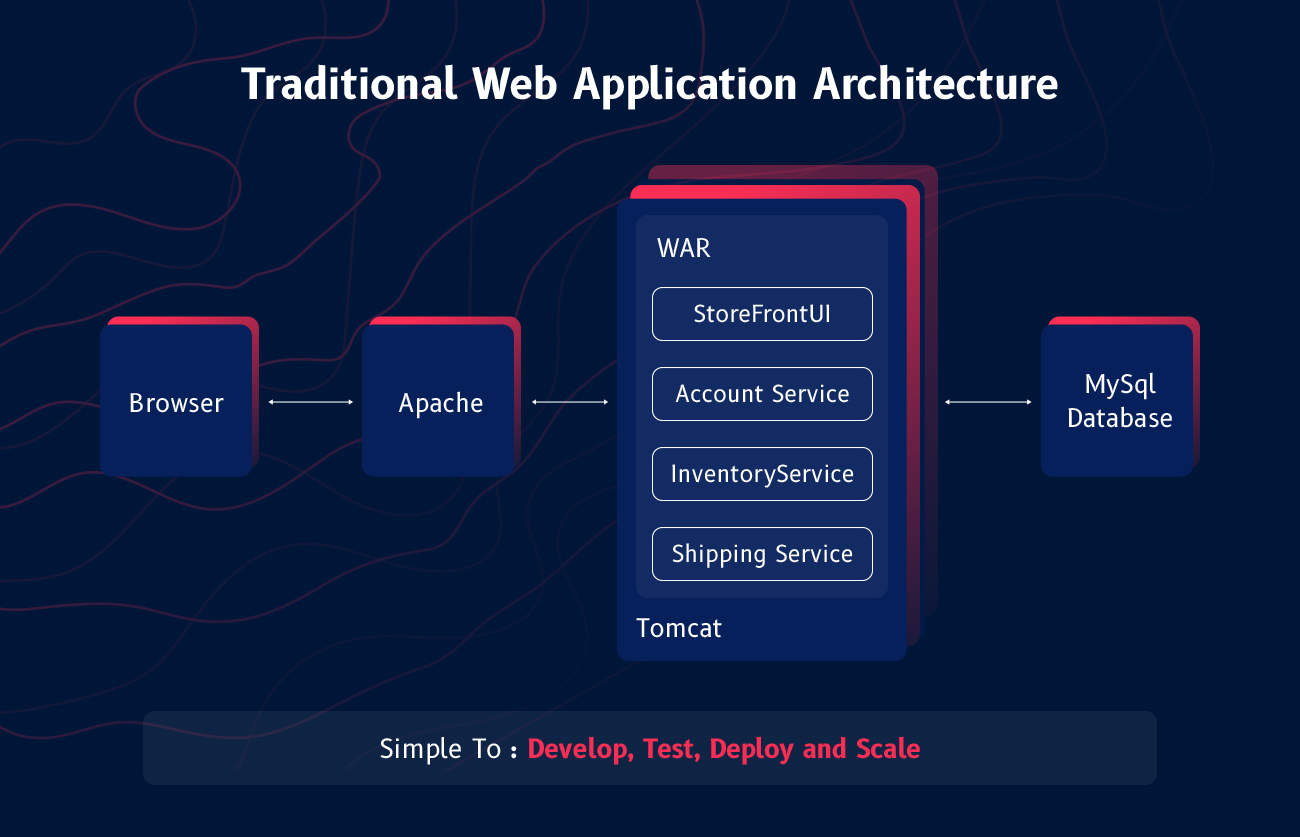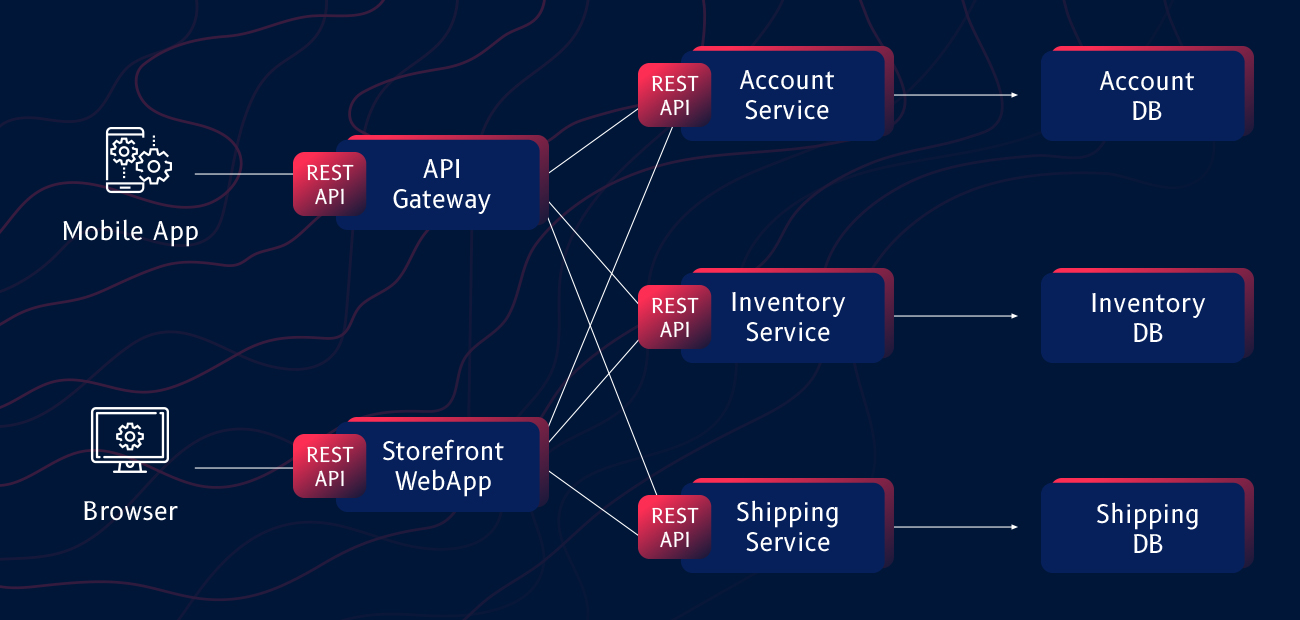What Should A Startup Choose: Monolith Or Microservices Architecture
Published on 16 Mar 2020

What Should A Startup Choose: Monolith Or Microservices Architecture
Monolithic VS Microservices Architecture
For a long time, we have been developing software as one huge application that contains all the features. That’s the Monolithic Architecture and the problem with it is when we deploy a new feature, it will have an impact on the stability of the entire application. As the user base grows, we need to scale the entire application and the infrastructure. For example, when building an e-commerce web application that takes orders from customers, checks product inventory, authorizes payment, and ships the product. The application will have a few components like the StoreFrontUI i.e the user interface, and a number of backend services for checking credit, maintaining inventory and shipping orders.
Even though the application has many components/modules/services, the application is built and deployed as one Application for all platforms (i.e. desktop, mobile, and tablet) using RDBMS as a data source.

On the other hand, in Microservices Architecture, we have a collection of small applications, running on their own environment and communicating with each other through APIs. The biggest perk of using microservices is that each part of the application can have its own development cycle and when you have to scale, all you have to do is scale the services that are attracting traffic. If we go back to the e-commerce web application example again, it consists of various components/modules. In the microservices architecture, each component/module can be a loosely coupled service and can interact with each other as needed. Following are the services for the complete application:
Authorization Service — authorizes customers.
Order Service — processes orders.
Inventory Service — maintain product inventory.
Payment Service — process payments.
Shipping Service — Ships ordered products.
Let’s Compare Monolithic and Microservices Architecture

Pros and Cons of Monolithic Architecture for Startup Applications:
Pros of Monolithic Architecture Based Applications:
- Simple to develop – current development tools and IDEs support the development of monolithic applications. When you start a project it’s easier to go the monolithic way.
- Simple to deploy – all you have to do is deploy one binary
- Debugging & Error tracing – Easy to track bugs since all the transactions are logged into one place.
- Simple to test – perform end-to-end testing of the application in one go.
- Less Costly – Operational costs are reduced as there is only one application that you need to set up logging, monitoring, and testing for.
Cons of these Applications:
- Difficult to understand and modify – the codebase can be a little intimidating especially if you are new to the team.
- The start-up time of the application can be affected based on the size of the application.
- Every time you make an update, you have to redeploy the entire application.
- Overloaded IDE – once the codebase becomes too large, the IDE will slow down and the developer productivity will reduce.
- Scaling the application is difficult – scaling with increasing transaction volume is possible but you can’t scale this architecture with increasing data volume.
- Difficult to adopt new and advanced technology – change in language or framework affects the entire application. A shift in terms of technology can prove to be costly.
Pros and Cons of Microservices Architecture for Startup Applications:
Pros of Microservices Architecture:
- Ensures continuous delivery and deployment of large, complex applications.
- Better testability — since services are smaller and faster to test.
- Better deployability — each service can be deployed independently.
- IDE is faster hence, developers can be more productive.
- No long-term commitment to technology – when developing a new service, you can start with a new technology stack. You can also rewrite existing services in new technology.
Cons of these Applications:
- Increased memory consumption – It uses N*M service instances instead of the N instances in the monolithic applications.
- Initial Costs are very High and this type of architecture demands for proficiency in the skills of the developers.
- Testing is difficult and time-consuming because there is an additional complexity involved because of the distributed system.
- Deployment Complexity – there is added operational complexity of deploying and managing a system that contains various service types.
From Monolithic to Microservices Architecture: Real-World Example
Here’s an example of how Startups should be agile enough to change the Architecture based on the need of the Application. A real-time example to note here should be Netflix.
Netflix initially started as a website that sold DVDs, they began as a monolithic application.
Now that the company has transitioned to a platform that streams content to millions of viewers all over the world, Netflix moved to a microservices architecture. This allows for receiving content from various sources, getting it into its systems, processing it, and distributing it to users seamlessly.
Creating a new product is all about risk. And choosing the right architecture is an essential step toward success. So, if you need help with your application architecture design, let Systango be your Technology Partner in Driving Success.How Can Systango Help Your Software Company?
Get in Touch For A Free Consultation Today!
Every day, Netflix’s API handles hundreds of millions of calls, which are passed around between microservices in order to accomplish a task. When you play a movie, you trigger a series of five API calls. This keeps track of playback, collects content for the user interface, manages streaming services, and more.
Netflix also uses serverless architectures, which can be used easily with microservices to encode this content, backup files, secure their assets, and monitor their IT environment.
So which Architecture should you use for your application?
Well, both the architectures have their pros and cons, the architecture of any application is based on product/project requirements. First of all, define the needs, the scale & funding of your enterprise: Lightweight applications or limited budget applications should be built using a monolithic approach, A good example is ETSY and if needed you can also gradually shift to a Microservices architecture approach (Disclaimer: It will be tough). Microservices architecture is more suitable when your service is quite large, and you work with big data, and you have the money to work with multiple cross-functional teams to be able to perform different tasks simultaneously. If you are still confused about the best architecture between monolithic VS microservices for your application, get in touch for a free consultation.
Related posts
App Development
Mobile Apps
Technology
Web Apps
Building Your App? Rust vs Go: A Guide for Business Owners
21 Feb 2024
Blockchain
News
NFT
Software Development
Technology
Web 3
How Systango Pioneered USA's 1st NFT Ticketing Marketplace for Veraticket?
01 Feb 2024
Let’s talk, no strings attached.

